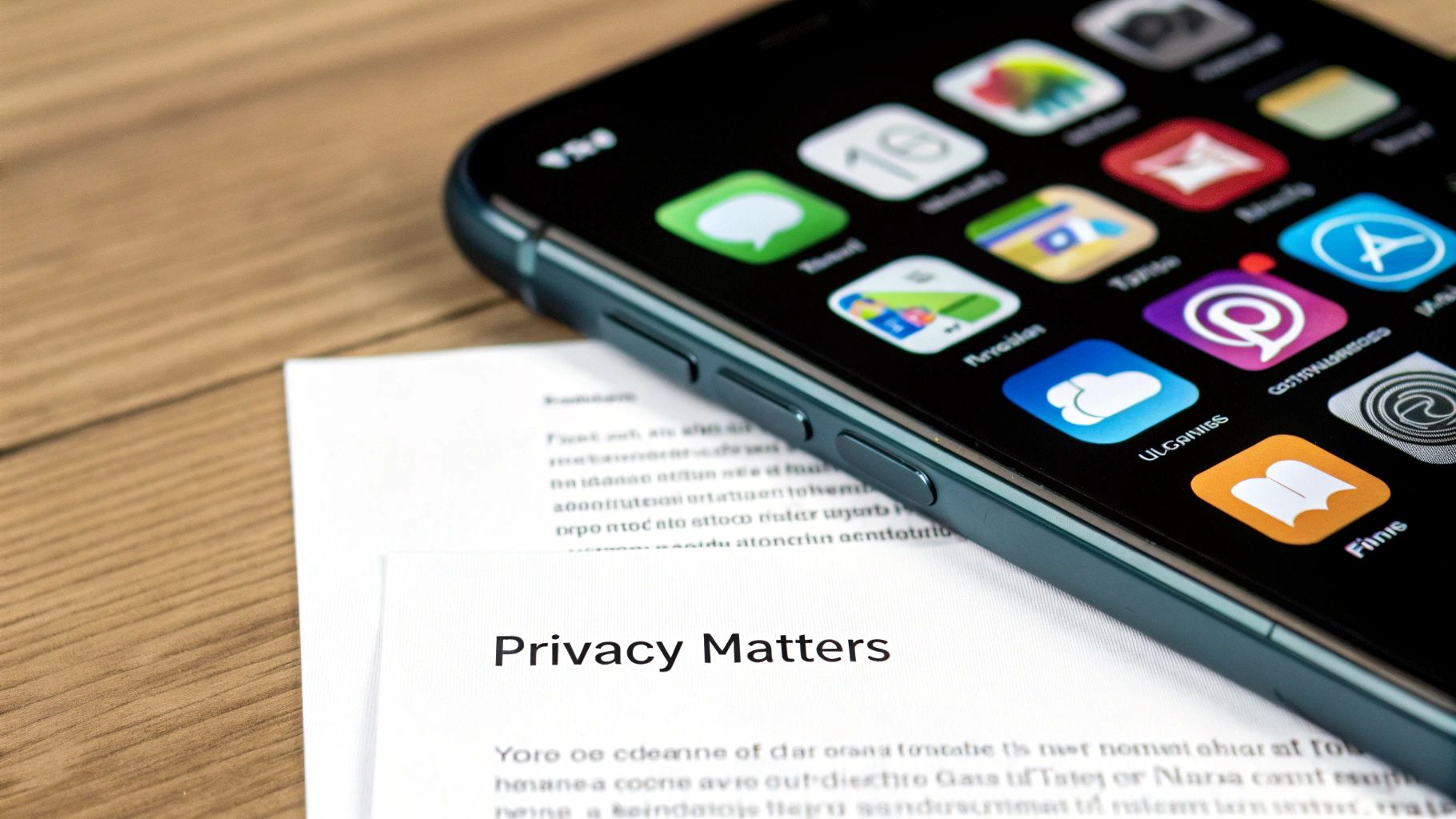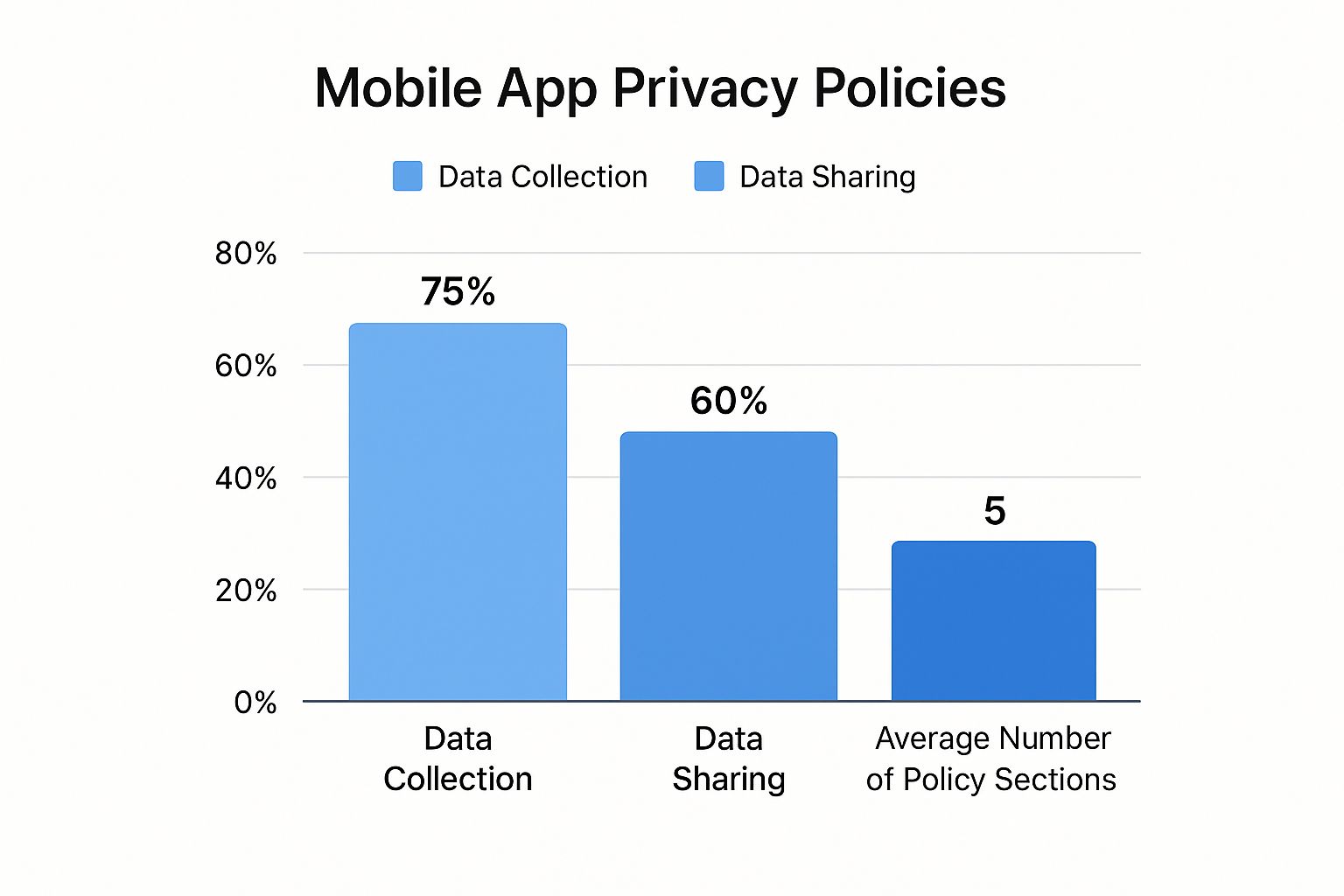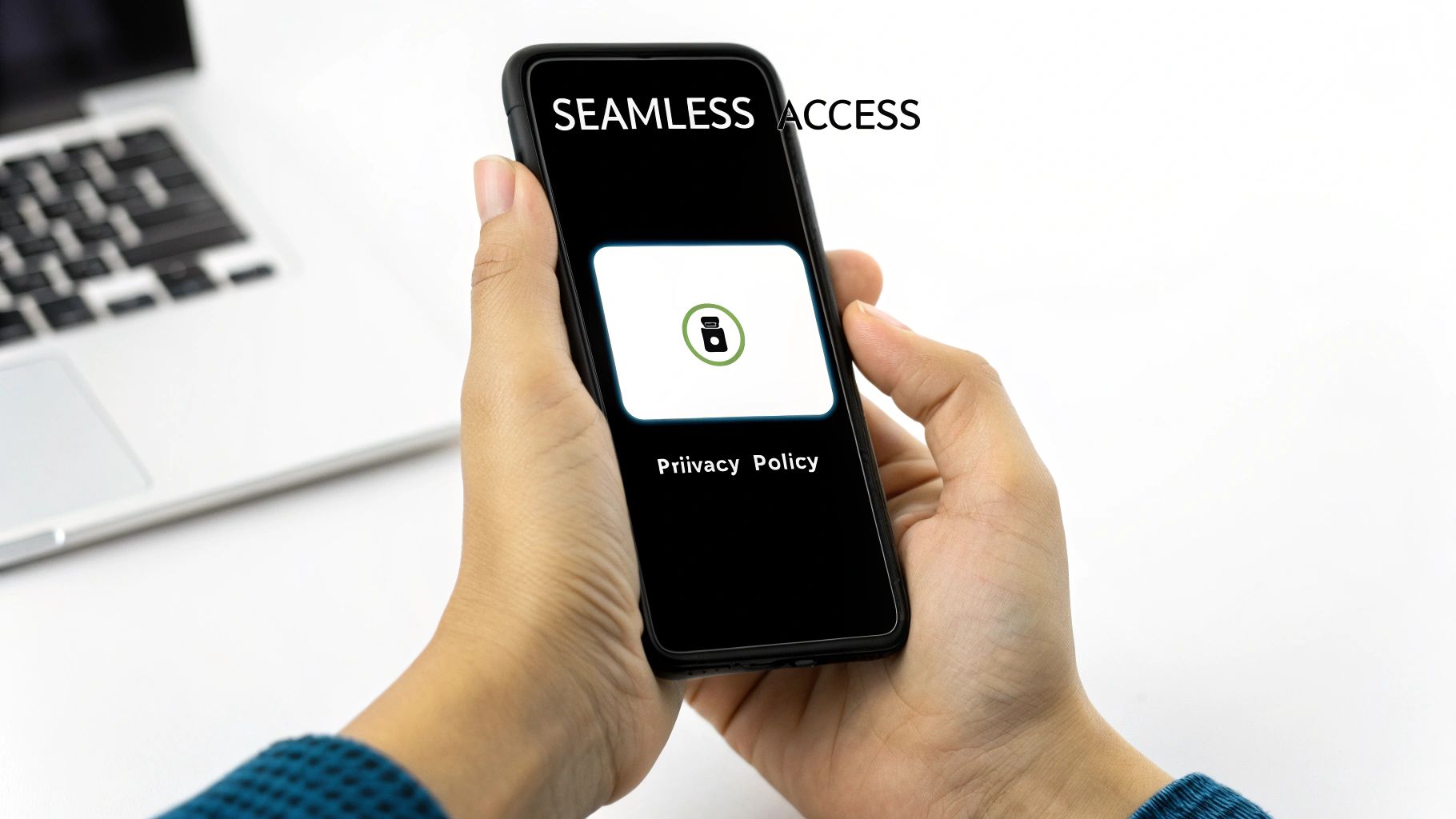Privacy Policy Mobile App: Your Essential Guide
October 7, 2025

A solid privacy policy for your mobile app is more than just a wall of text nobody reads. It's a legal document that lays out exactly how you handle user data—what you collect, why you collect it, and who you share it with. This isn't just a "nice-to-have." It's a hard requirement from app stores like Apple and Google, and it's the foundation of your relationship with your users.
Why a Privacy Policy Is Essential for Your App’s Success#

Let's be real—drafting a privacy policy can feel like a chore, another legal box to tick before you can finally launch. But if you see it that way, you're missing the point. A clear, honest privacy policy is how you build trust, and trust is what keeps users coming back.
People are more aware of their digital footprint than ever before. Being transparent about data isn't just good practice; it's a genuine competitive advantage. When you write a policy that shows you respect user data, it can directly boost your downloads and retention. Users who feel secure are far more likely to stick around, use your app's features, and maybe even spend money.
Meeting Legal and Platform Mandates#
Beyond building trust, a robust privacy policy is a non-negotiable legal and platform requirement. Major data protection laws have a global reach, which means your app almost certainly has to comply, no matter where your company is based.
You'll need to get familiar with a few key regulations:
- General Data Protection Regulation (GDPR): This sets the standard for processing data from anyone in the European Union.
- California Consumer Privacy Act (CCPA): This gives California residents specific rights over their personal information.
- Children's Online Privacy Protection Act (COPPA): If your app is aimed at kids under 13, this law imposes very strict rules.
Ignoring these can lead to massive fines, your app getting booted from the stores, or worse. Both Apple and Google have made it crystal clear: no privacy policy, no app submission. If you want a deeper look at the platform rules, our guide on navigating the https://nextnative.dev/blog/app-store-review-guidelines is a great place to start.
A privacy policy is more than just a legal shield; it's a public commitment to your users. It signals that you take their data seriously and are a responsible steward of their information.
The Strategic Value of Transparency#
The investment in data privacy is exploding. Projections show that global spending on security and risk management is on track to hit USD 212 billion in 2025. On top of that, over 60% of large businesses are expected to be using Privacy-Enhancing Technologies by the same year. The trend is obvious: protecting user data is now a core business priority.
At the end of the day, a great privacy policy isn't just a document—it's a part of your business strategy. It lowers your legal risk, builds brand loyalty, and makes sure your app meets the expectations of today's users. Understanding the value of dedicating time to information security policy development makes it clear why putting in the effort now pays off big time down the road.
Mapping the Data Your App Actually Collects#
Before you can write a single sentence of your privacy policy, you need to become a data detective. An honest, transparent privacy policy for a mobile app starts with a crystal-clear understanding of what data your application actually gathers. Without this foundation, you’re just guessing, and that can lead to an inaccurate, incomplete, and non-compliant policy.
This process is often called a data audit or data mapping. It's about meticulously cataloging every single piece of information your app touches—looking under the hood to create a complete inventory. Think of it like a chef listing every ingredient before writing a recipe. You can’t describe the final dish if you don’t know what’s in it.
This bar chart gives you a quick look at how common certain sections are in existing mobile app privacy policies.

As you can see, while most apps mention data collection, far fewer are upfront about data sharing. That gap is a huge opportunity to build trust with your users.
Differentiating Data Sources#
Your data map needs to distinguish between two primary categories of information. A good place to start is by identifying what users actively and knowingly give you.
- User-Provided Data: This is the most straightforward category. It includes any information a user types into a form or actively shares, like their name and email for account creation or payment details for a subscription.
- Automatically Collected Data: This is where things get less obvious. Your app likely collects information in the background to function correctly or improve the user experience. This includes things like device IDs, IP addresses, crash logs, and usage analytics showing which screens a user visits most.
This distinction is crucial because users are often completely unaware of the data being collected automatically. And it's happening a lot. A striking 72.6% of iOS apps track private user data in some form, with free apps being four times more likely to do so than paid ones. This reality is a big reason why so few smartphone users feel in control of their personal information. You can dig into more stats about the state of data privacy on ExplodingTopics.com.
Don't Forget Third-Party Services#
A common blind spot for many developers is the data collected by third-party SDKs and services you’ve integrated into your app. These tools are incredibly useful for analytics, advertising, or payments, but they come with their own data collection practices that you are now responsible for.
Your privacy policy is responsible for the data collected by third parties on your behalf. Simply saying "we use a third-party service" isn't enough; you must understand and disclose what they are collecting through your app.
For example, your analytics service might be collecting detailed location data or device information that you aren't directly accessing but are still responsible for disclosing. This underscores the need to thoroughly review the documentation for every single third-party service you use.
Making sure this data is handled securely is a critical part of your responsibilities. For a deeper dive into this topic, check out our guide on mobile app security best practices. Taking the time to create a detailed map now will save you from major legal headaches and trust issues down the road.
To help you get started, here's a quick reference for the types of data your app might be collecting.
Common Mobile App Data Collection Points#
| Data Category | Specific Examples | Common Purpose |
|---|---|---|
| Personal Identifiers | Name, email address, phone number, user ID | Account creation, communication, support |
| Financial Information | Credit card numbers, purchase history | Processing payments, in-app purchases |
| Location Data | GPS coordinates, IP-based location | Location-based features, analytics, targeted ads |
| Device & Technical Data | Device ID, model, OS version, IP address, crash logs | App functionality, performance monitoring, security |
| Usage Data | Features used, time spent in app, screen views | User experience improvement, feature prioritization |
| User Content | Photos, contacts, messages, calendar entries | Core app features (e.g., photo sharing, messaging) |
| Third-Party Data | Analytics IDs, ad network identifiers | Analytics, advertising, service integration |
This table isn't exhaustive, but it covers the main areas you need to investigate. Treat it as a starting point for your own data audit. The more thorough you are here, the stronger and more trustworthy your privacy policy will be.
Building the Key Sections of Your Privacy Policy#

Alright, with your data map finished, you're ready to start putting the actual document together. A solid privacy policy for a mobile app isn't just a wall of legal text; it’s a clear story that guides users through your data practices. Think of each section as a building block. When you combine them, you create a strong foundation of trust and transparency.
Your main job here is to translate all that technical data collection into simple, plain language. Ditch the dense legal jargon whenever you can. The more straightforward you are, the more likely users will actually believe you’re being upfront about how you handle their info.
Let's break down the essential pieces you'll need.
What Information You Collect#
This is your first big section, and it flows directly from the data mapping you just did. You have to be specific and thorough here. Kick things off by listing the different types of data you gather, using the same categories you identified earlier: user-provided, automatically collected, and third-party data.
For example, don't just say "we collect personal information." That's way too vague. Break it down like this:
- Account Information: We collect your username, email address, and password when you sign up.
- Device Details: We automatically gather your device model, operating system version, and unique device identifiers to fix bugs and ensure the app works correctly.
- Usage Analytics: We track which features you use to help us decide what to build next.
Getting this specific shows you've actually thought about it and aren't trying to hide anything. This is where you set the tone for the entire policy.
How and Why You Use This Information#
After you tell people what you collect, the next question they'll have is, "Why do you even need this?" This section is your answer. It's also a legal must-have under rules like GDPR, which demand a "lawful basis" for processing data.
You need to connect every single piece of data to a legitimate purpose. If you collect location data, explain that it's to power your map feature or show local content. If you ask for an email, clarify it's for account security, password resets, and sending critical service updates.
Transparency about your purpose is non-negotiable. It's not enough to say you collect data "to improve our services." You have to explain how that data helps you improve.
For instance, you could say: "We analyze crash reports, which include your device model and OS version, to identify and fix stability issues. This leads to a better user experience in future updates." That level of detail builds credibility and shows you’re being thoughtful, not just grabbing data for the sake of it.
Data Sharing and Third-Party Disclosures#
This is usually the most sensitive part of any privacy policy for a mobile app. People really want to know who else is getting their data. Be completely honest about any third-party services you use that handle user information, like analytics providers, ad networks, or cloud hosting services.
List out the categories of third parties and explain why you share data with them. It’s a great practice to also link to their privacy policies so users can dig deeper if they want. You might share anonymized usage data with an analytics service to understand user behavior or payment details with a secure payment processor to handle transactions.
User Rights and Data Control#
Empowering users is a cornerstone of modern data privacy. This section needs to clearly lay out the rights users have over their own information and give them simple, clear instructions on how to use those rights.
This almost always includes the right to:
- Access: How can a user get a copy of their data?
- Correction: How can they fix information that's wrong?
- Deletion: How can a user ask you to delete their account and all their data?
Provide a clear way to make these requests, like a dedicated email address or an in-app support form. Making this process easy shows you respect your users' control over their own data.
If you're feeling a bit stuck on the basic structure, a good app privacy policy generator can give you a solid template to build on.
Designing a Policy People Will Actually Read#
Let's be honest. A dense, unreadable privacy policy might tick a legal box, but it does absolutely nothing to build trust with your users. If they need a law degree to figure out what you’re doing with their data, you’ve already failed.
The goal isn't just to have a privacy policy. It's to create one that’s accessible, transparent, and genuinely user-friendly.
Forget the intimidating wall of text. The key to a policy people will actually scan is simple structure and plain language. Break down complex legal ideas into small, digestible chunks. Use clear, descriptive headings so users can easily find the information that matters most to them.
A few simple principles make all the difference:
- Use Plain Language: Swap out legal jargon like "heretofore" and "indemnify" for simple, everyday words.
- Incorporate Bullet Points: Lists are perfect for clearly explaining what data you collect or who you share it with.
- Keep Paragraphs Short: Stick to one main idea per paragraph. A good rule of thumb is no more than three sentences.
This approach shows you respect your users' time and attention, and it proves you genuinely want them to be informed.
Making Your Policy Easy to Find#
Even the most beautifully written policy is useless if no one can find it. Visibility is just as important as readability. You should place links to your privacy policy in several intuitive spots to make sure it's always just a tap away.
At a minimum, link to your policy from these key places:
- App Store Listings: Both the Apple App Store and Google Play Store require a link to your policy. This is often a user's first point of contact with your data practices.
- Onboarding Flow: Introduce your policy when a user first signs up. This sets a transparent tone right from the start.
- In-App Settings Menu: A "Legal" or "About" section in your app's settings is the most common place users will look for this information.
A "layered" approach is incredibly effective. Provide a brief, easy-to-understand summary of your key data practices upfront, with a clear link to the full, detailed policy for those who want to dig deeper.
The Modern User's Expectation#
As people spend more and more time on their phones, they're also getting smarter about privacy. For example, the average French citizen now has 30 mobile apps on their phone and spends over three hours a day using them.
This deep engagement has made users more aware of the risks when apps ask for sensitive permissions, like access to their location or photos. In response, regulators are pushing for more user-friendly designs. You can see some of their recommendations and learn more about creating privacy-friendly mobile apps on CNIL.fr.
At the end of the day, a readable privacy policy is about much more than just compliance. It's a powerful way to show your commitment to user trust and a core part of a positive user experience.
Keeping Your Privacy Policy Current and Compliant#

Hitting "publish" on your privacy policy isn't the finish line—it's just the starting gun. A privacy policy for a mobile app is a living document. It has to evolve right alongside your app and the constantly shifting world of data privacy laws.
If you treat it as a "set it and forget it" checkbox, you're setting yourself up for non-compliance and, worse, breaking the trust you've built with your users.
Think of your policy as part of your development cycle. Every time you add a feature that touches user data—like integrating a new analytics SDK or adding location services—your policy needs a fresh look. Before you push a new build, ask a simple question: does this change how we handle our users' data? If the answer is yes, it's time for an update.
Notifying Users of Changes#
Just changing the text on your policy page isn't enough. You have to tell your users what you've changed. How you communicate this is crucial for keeping that trust intact. Pushing a silent update, even with good intentions, can come across as deceptive.
There are a few solid ways to get the word out:
- In-App Notifications: A simple banner or pop-up when the user opens the app is the most direct route.
- Email Announcements: Sending a quick summary of the changes to your user base makes sure everyone is in the loop.
- Website Banners: A clear notice on your app's promo site or landing page works well, too.
For any significant changes, like collecting a new type of sensitive data, you'll often need to get fresh consent. This could be an in-app prompt that asks users to agree to the new terms before they can continue. For more detailed guidance, our tools can help generate a compliant Play Store privacy policy that ticks all the right boxes.
A great habit to get into is maintaining a version history of your privacy policy. It creates a transparent log, letting users and regulators easily see how your data practices have evolved.
The Importance of Regular Reviews#
Even if your app’s features are stable, the law probably isn't. New privacy regulations are popping up all the time.
Scheduling periodic reviews of your privacy policy mobile app—at least once a year—is a smart, proactive move. It helps you catch any gaps that have opened up because of new laws or updated platform requirements from Apple or Google.
This ongoing commitment shows you take user privacy seriously. It’s a continuous process that protects your users and shields your business from potential legal trouble and reputational damage.
Common Questions About App Privacy Policies#
Even with a good template, you're bound to hit a few tricky questions when drafting your first privacy policy. Let's walk through some of the most common ones I hear from developers to help you get this done with confidence.
What If My App Collects Zero Data?#
This is the big one. "My app doesn't collect anything, so I don't need a policy, right?" Wrong.
The answer is a hard yes, you still need one. Both the Apple App Store and Google Play Store require a privacy policy for every single app, no exceptions.
Even a simple, one-paragraph policy stating that you don't collect, store, or share any user data is enough. It ticks the box for the app stores and, just as importantly, builds trust with your users by being upfront.
How Do I Handle Third-Party Services?#
Almost every app uses third-party tools. Think Google Analytics, Firebase, Stripe, or social logins. If you use any of these, you're technically allowing them to collect data through your app.
You have to disclose this. Your policy needs to name these services and, ideally, link out to their own privacy policies. This gives your users the full picture of who has access to their information.
For example, if you're using social logins, you're touching sensitive user profile data. It's a good idea to review the data considerations when integrating things like authentication with the Google API.
Do I Need a Lawyer to Write My Policy?#
This is a very practical concern, especially for solo devs and small teams on a tight budget. The good news? You probably don't need a lawyer to draft your first version, especially if your app's data practices are simple.
Using a reputable privacy policy generator is a great starting point and can give you a solid, compliant foundation.
However, if your app handles highly sensitive information—like health data (HIPAA) or financial details—or is aimed at children (COPPA), then getting professional legal advice is no longer optional. It's essential.
The most important thing is to be honest and clear. Your goal is to accurately describe what your app does in plain language. A legally perfect policy that misleads users is far worse than a simple one that's truthful.
How Often Should I Update My Policy?#
Your privacy policy isn't a "set it and forget it" document. It's alive. It needs to change whenever your app's data practices change.
You'll need to push an update for things like:
- Adding a new feature that collects a new type of data (like location or contacts).
- Integrating a new third-party SDK for ads or analytics.
- Major changes in privacy laws (like GDPR or CCPA) that affect your users.
As a rule of thumb, review your policy at least once every 12 months, even if you think nothing has changed. It's a quick check that ensures you stay compliant and protects both your users and your business.
Ready to build your app without the steep learning curve of native development? NextNative provides production-ready templates and tools to launch your iOS and Android apps using the web technologies you already know. https://nextnative.dev
Explore more
- How to Convert Your Next.js App to iOS & Android
- How to Add Push Notifications to Your Next.js Mobile App
- How to Add In-App Purchases to Your Next.js App
- How to Build an iOS App with Next.js in 2025
- How to Deploy Your Next.js App to the App Store
- Next.js vs React Native
- Capacitor vs React Native
- Capacitor vs Flutter
- Capacitor vs Ionic
- Next.js vs Expo
- PWA vs Native App